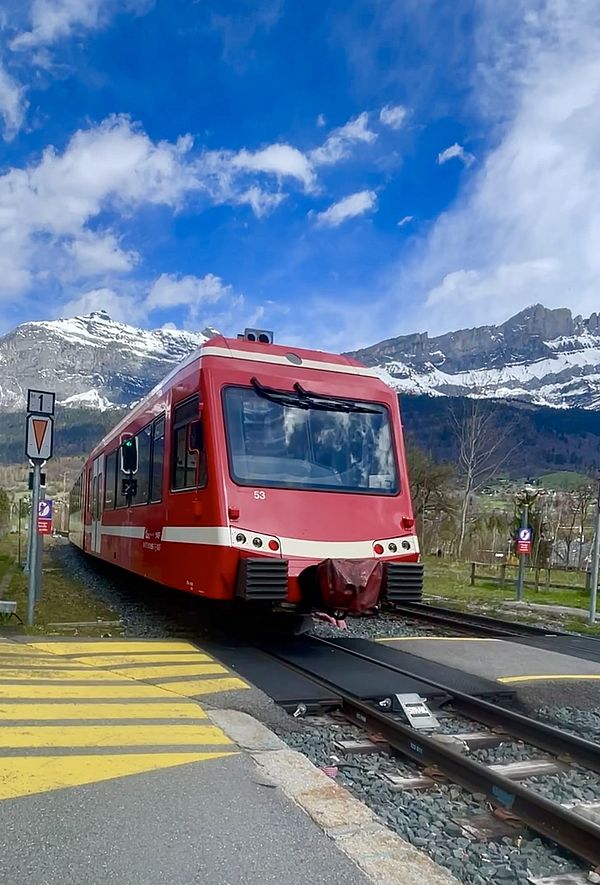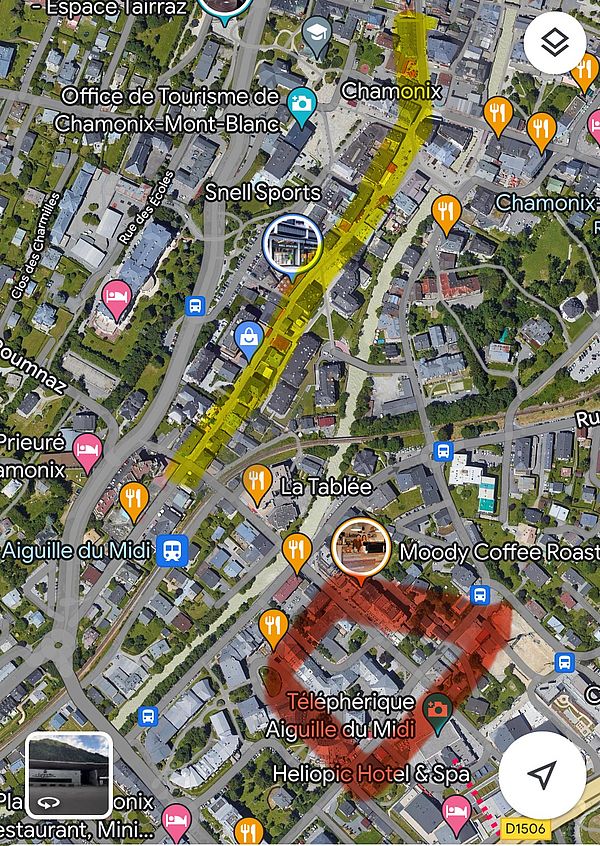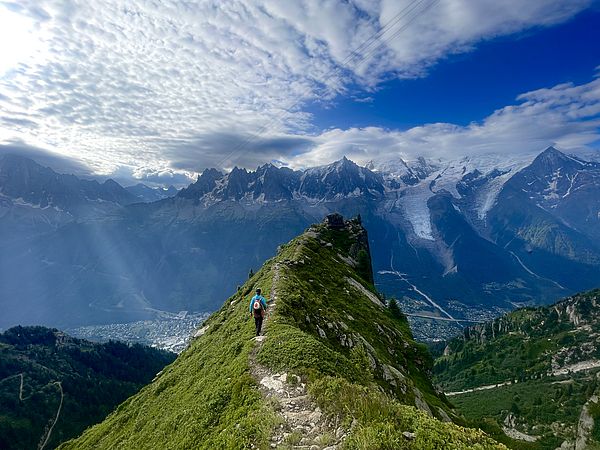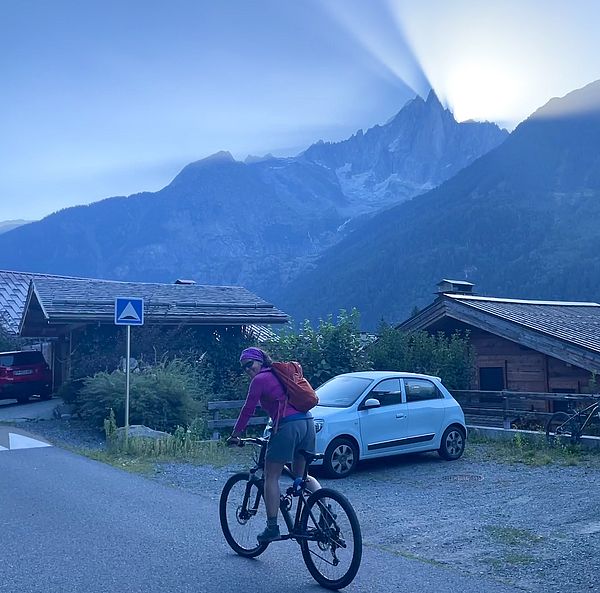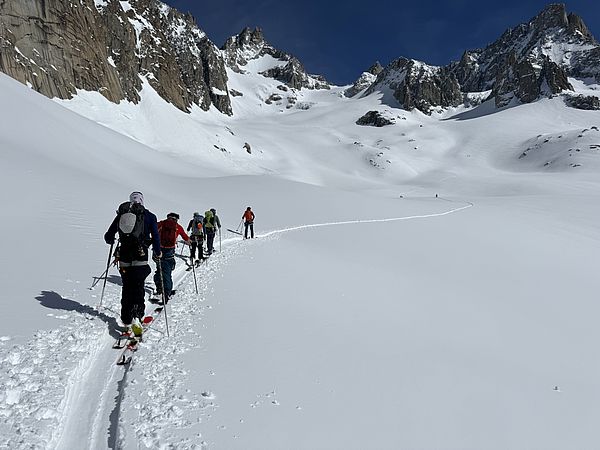For almost 300 years, Chamonix has been an epicenter for adventure in the high mountains. Arriving in town and staring up at the jagged jaw of the Mont Blanc Range to your front and the Aiguilles Rouges Range to your back, it's clear you're in the belly of the beast when it comes to alpine climbing. Perhaps the most amazing thing about this beast is the ease of access that Chamonix provides to alpine objectives, allowing you to easily climb two to three times as many routes as you might on a similar trip to the Bugaboos, Cascades, or Alaska. That said, knowing a few things about how best to navigate this beast once you're there.
Lodging
As with any adventure destination these days, you'll find a range of hotel and short-term rentals. And, though diminishing, you can also find a few hostels and campgrounds that are walkable from Chamonix Centre. Generally speaking, the cheapest ones are down in the large apartment buildings that surround the Aiguille du Midi base station. Because a lot of our climbs are accessed via the Midi gondola, these options are also convenient. However, this area—known as “Cham Sud”--tends to be party central. Given that most European lodging doesn't have air conditioning, you'll likely be sleeping with the windows open...and given that the nearby L'Amnesia nightclub opens at 1am, you can imagine what things sound like right around sunrise...if you stay in Cham Sud, bring some industrial strength earplugs and be ready for some unplanned “alpine starts”.
Similarly, because Rue de Paccard is the pedestrian shopping zone for the city, you'll find that options directly on Paccard can be noisy and sometimes it's nice to be able to get away from the chaos of the city center.
If you wish to be a bit further out of town, the bus service is pretty good. Generally speaking, given the various bus schedules and the potential for early AM starts, I wouldn't stay further southwest of town than the Les Gaillands neighborhood and I wouldn't stay further northwest than the village of Les Praz.
No matter what part of the valley you're in, here's a consideration regarding aspect: When you're perusing the various short-term rental photos and salivating over the ones that offer views right onto the Mont Blanc range, do just keep in mind that A) these are facing the late afternoon sun and B) most accommodations don't have air conditioning. While this can add appeal in the winter, during the summer month it means your place is going to be on the warm side until the sun goes down.
And, lastly, since most US flights arrive in Geneva in the AM, it's worth checking in with your host to arrange for an early check-in, so that you're not stuck with your luggage all of your first day in Chamonix and can get out and explore and acclimatize. If yu're not able to arrange for early check-in, Bounce offers useful short-term luggage storage options around town.
Lift Tickets
All the lifts in the Chamonix area are run by the Compagnie du Mont Blanc/Mont Blanc Natural Resort. Though their prices and price structures are constantly changing, any US-based person will find their pricing to be quite reasonable. Though the specifics change,broadly speaking, there are two types of passes. One of them provides access to most lifts, but not the Montenvers Train or the Midi Gondola. The other pass is all-access. You’ll want the all-access pass, currently called the “Multi-Pass”. The other primary decision is whether you want a pass for consecutive versus non-consecutive days. This decision is something of a function of how many days in a row you/we are planning to climb (plus any acclimatization hiking days you have in mind) and could also be a function of weather forecasts. Whatever strategy you go with, as you'd expect, each additional day gets substantially cheaper, so it'd likely be best to buy as many days as you think you'd conceivably use. For any spring time skiing or climbing, it's worth exploring the Ikon Pass back in the US, as they recently formed a partnership with the Compagnie.
Acclimatization
Chamonix is at 3000'/1000m. With all of the lift and train options rising right out of the center of Chamonix, it's pretty easy to get acclimatized. Since most US flights arrive in Geneva in the AM, it is possible to get to Chamonix, move into your place (request an early check-in from your host), and get up high for a few hours in the afternoon. The best choice is likely going to be the Brevent/Planpraz lift, as it doesn't require reservations and is usually quiet in the afternoons (unlike the Midi Gondola or Montenvers Train). You could either take the lift to the Planpraz mid-station and then hike up to the Brevent top station or do it in reverse. Going up is much harder on the lungs; going down puts more wear and tear on the knees. Either way this will get you in the zone between about 6000'/2000m and 9000'/3000m. Then grab a soda or an ice cream at either lift station to further your time up high. Bring a book and read for a bit for extra acclimatization points.
On subsequent days, check the other hike options listed below. Apps like “AllTrails” are good for providing more specific details. Whatever options you choose, remember that mountain navigation can be tricky, especially when visibility is low, so be sure to have some paper and/or phone based maps available (and a full battery). Additionally, though it may feel warm down in the valley, temps up high can be quite cool and the weather can change quickly—pack accordingly. Lastly, there is more snow up there than you might often think, particularly in early summer. If you're unsure of conditions, pack your crampons and be prepared to change your plan if the route doesn't look advisable.
- Index to Brevent: In the morning, either walk 25 minutes from Chamonix Centre to the village of Les Praz or take the bus up valley. Get on the Flegere lift. After getting off the Flegere lift, follow the trail signs for Brevent/Planpraz. You can also continue up to L'Index to start your journey, but this involves more descent. Either way, you'll basically be doing a balcony traverse across the Aiguilles Rouges at about 7000'/2100m, enjoying stunning views of The Mont Blanc Massif the whole way. Descend via the Planpraz lift.
- Index to Lac Blanc: Follow the same morning plan as described above, then get off at the top of the Flegere lift and follow trail signs up to Lac Blanc, a stunning alpine lake that is embedded in snow and ice for much of the early part of the summer. Return via the same path.
- Montenvers to Plan du Midi: Take the morning Montenvers Train—get there at or near the first train, as the crowds grow as the day goes along and there are no reservations. Once disembarking, follow the trail signs for Plan de l'Aiguille (the Midi Gondola mid-station). Basically, you'll be doing a balcony traverse from about 6000'/2000m to 8000'/2300m along the northwest flanks of the Mont Blanc Massif, with lovely views of the Aiguilles Rouges across the valley.
Climbing Research
Immediately upon arriving, you’ll see there is a deep range of climbing around Chamonix for us to explore. While I’ll certainly have a great plan in mind based on the weather, seasonal conditions, and our conversations in advance, you may enjoy doing some research and edification of your own.
Camp-to-Camp is the best online resource for climbing information. It is similar to Mountain Project in the US; however, whereas Mountain Project entries are all user-generated, with Camp-to-Camp (it appears/my understanding is) the entries have been made by the company and then people can add their own trip reports and photos afterwards. When you’re perusing around Camp-to-Camp, you’ll notice that many of the climbs have links to a YouTube channel called “TVMountain”. This enterprise has done a remarkable job of cataloging videos of many of the most popular climbs, typically editing them down to 15-30 minute highlights that give a good feel for the kind of climbing you might encounter.
For a nominal fee ($8/month in 2024) you can access RockFax Digital Guidebook. Download the app on your phone and then purchase the Chamonix book. This book gives you a broad view of the selection of climbs in the area, in an fairly user-friendly format. For longer routes, be aware that the topos and descriptions listed in RockFax are inadequate, and greater research is necessary elsewhere.
If you're interested in looking at opinions about the weather, MeteoBlue and Mountain-Forecast are good options. Of course, keep in mind that meteorology is second only to economics in terms of its inability to predict the future! For recent route conditions and information, La Chamoniarde offers some updates.
Best Supermarket
Spar, Casino, Carrefour, and SuperU are your primary supermarket options in Chamonix and I listed those in ascending order of superiority. Spar is the most swanky of the options—and you're going to pay almost double for many items for that swank. I'm pretty sure the only way it stays afloat is by taking advantage of tourists who haven't yet figured out the other options. Carrefour is fairly large, with decent prices, but is a slightly longer walk out of town. “Casino” is pretty nice and is centrally located in the main pedestrian area, though a bit small. There are some “Petite Casinos” around town as well, but you'll find higher prices and more limited selections there. I'm a solid fan of SuperU. Located at the far Northeast end of the pedestrian center, it's the largest market in the valley, has the lowest prices, and has a great array of options—everything from Thai curry paste to fresh sea urchin at the seafood counter. Be sure to note that there is an entire basement floor below the ground floor, with stationary, toiletry, and additional food offerings.
Generally speaking, as long as you're a person who tends more to “shop the perimeter” of the supermarket (e.g., dairy, eggs, produce), you'll find that all the supermarket prices (except at Spar) will be substantially lower than the US, even given Chamonix's slightly inflated prices.
One note about all of these supermarkets: As with the US, European supermarkets have gradually expanded to include butcher, baker, cheese, and other counters, such that you could do all your shopping in one place. But if you do all your shopping at the supermarket, you're going to be missing out on some of the most memorable cultural and gastronomical moments of a French adventure. Be sure to explore some of the smaller specialty markets—in particular, the bakeries—and the Farmers Market on Saturdays is not to be missed. You'll find it down in the plaza across from the Ecole Nationale de Ski et Alpinism (ENSA—The French Mountain Guide college).
Other Eats
With such a plethora of awesome bakeries, cheese, meats, and produce to choose from, it's pretty easy to enjoy DIY high-test breakfasts and delectable lunches, saving your dining dollars for dinner options. Chamonix has a bit of everything in terms of ethnicity and price, from Indian food, to kebabs, to sushi. In the ethnic grab n' go category, I highly recommend Ela for Mediterranean wraps and similar items, and Annapurna is a perennial favorite for Central Asian cuisine. But, of course, Chamonix really shines in the continental European food category and—most specifically—with Savoyard cuisine. Two options worth noting in this category are Le Tablee and Le Serac. A few popular, middle-of-the-road, general food fare options are Little Boxes, Bighorn Bistro and The Big Mountain Brewing Company. And two improbably good budget sit-down options include Cool Cats, with its eclectic hot dog selections (including vegetarian) down by L'Arve (the river that flows right through town) and Le Shack, with a rotating array of smartly-priced and interestingly-prepared street-food bites, alongside an array of beverages. Both of this last options offer only outdoor seating, so dress accordingly.
Similarly, there are a variety of places to grab a drink. There are a few micro-breweries in town, including the aforementioned Big Mountain Brewing, and Micro Brasserie Chamonix. While European brewers tend to shine in the more traditionally European brew categories like Pilsner, Wheat, and Belgian, American IPA lovers will probably not come away impressed. What is impressive are the views you can find with your brew: Nothing like holding a cold beverage in one hand while gazing up at the skyline and tracing the line you just climbed with other. My personal favorite for skyline viewing is La Folie Douce. This stately, old but recently renovated is uphill from the pedestrian center and has a massive front porch that's perfect for sunset spectacles. And, adding to the spectacle, they've got these quirky floor shows that roll through the place on the regular throughout the evening. And bonus points for the place if you've got smaller kids, who seem to have an indefatigable love for the giant trampolines. This place is fun.
And, on the note of beverages, though wines aren't my thing, I've been told that France makes some. All kidding aside, though I’m no wine connoisseur, it seems that the quality of any bottle of wine in the US can be found for roughly half the price in France.
Phone Cards
For shorter trips, it's likely the best phone option is to just pay your US providers daily European rate (Verizon is currently $10/day). For longer trips, it could be worth your while to investigate the many different SIM and “Simulated SIM” cards out there. In my experience, a company called “Free” offers the best options—though not exactly free, some plans start as low as 5 Euro a month. These days I have a 20€ a month “Free” plan that offers unlimited access in Switzerland & Italy—which is quite useful given that when you’re in the mountains you'll often be pinging off of towers across the borders. And, on the note of cell towers, I've found the Free reception to be pretty good in most areas around the Mont Blanc Massif. The challenge with the Free program is that you've got to go 30 minutes down the valley to the “Tabac du Mont Blanc” store in Sallanches to purchase the SIM. Though a hassle, it's worth considering for longer trips.
There are also “Virtual SIM” options like “Airalo”. I’ve used Airalo, but seem to end up being charged by Verizon for days that I was supposedly using Airalo. A last thing that you should consider–particularly if you’ll be in Europe awhile–is downloading “WhatsApp” and creating an account. Many Europeans use this for communication. It basically is a texting function that you can use through wifi, such that you don’t have to enable the cellular function on your phone.
ATMs & Finances
For unknown reasons, some ATMs in Chamonix tack on a percentage-based service fee in addition to the standard flat fee. These can be pretty exorbitant. So, if you're at an ATM that does this, close the transaction and try a few others. I've had good luck with the ATM attached to the Bank of Savoie building in the central pedestrian zone.
On the note of finances: Before leaving the US, be sure to contact your bank to let them know you’ll be using your credit card in France. Otherwise, the security features on the card might flag the use and lock your card.
Luggage Storage
If you or anyone in your crew are looking to leave Chamonix for a few days, Bounce offers a useful luggage storage option. It’s organized a bit like AirBnB, with you leaving your luggage at a shop or other retail establishment. Prices in 2024 were 5€/day.
Public Transportation
All the area lodging options will likely provide you with a card that gets you on the public transportation at a free or discounted rate; be sure to ask your host about this beforehand or when checking in. Then, once you buy a Mont Blanc Unlimited Pass (the pass for all the lifts, plus the Montenvers Train and Midi Gondola), you can also use that for free bus transport. There are bus stops all over town, but the two biggest are on Avenue de Courmayeur in Cham Sud and the one near the traffic circle at Avenue du Mont Blanc.
There is also a train station in the center of town. Unfortunately, the direct train only goes down valley as far as Le Fayet (so you can't go all the way to Geneva without several transfers), but you can take it up valley to Argentiere, Vallorcine, and onward to Martigny, Zermatt, and beyond. It generally rolls through Chamonix about once an hour in each direction (but doesn't go too late at night).
If you're looking to explore further-flung destinations, a car will be handy. Red Panda Car Rental offers a convenient option—though you will pay for that convenience. Another quirky European car rental option is provided through supermarkets like Carrefour and SuperU. At many of their larger locations, they offer very economical car rental options. However, in Chamonix it's a bit of a “Catch-22” in that the nearest options are down near Sallanches, beyond easy train or bus travel, so it's almost like you need a car to get to your rental car.
Outdoor Gear & Shopping
Chamonix probably has more climbing and ski mountaineering stores per capita than any town in the world. The biggest one, with the highest amount of brands you might recognize from shopping in the US, is Snell Sports. My favorites for finding good deals are Decathlon (a European chain; the Chamonix store is small and has limited offerings, but still worth checking out) and Technique Extreme (lots of screaming deals, particularly on their in-house manufactured items). For any rental needs, Snell and InterSport are good options.
Travel & Rescue Insurance
As we all know and have likely experienced, sometimes travel doesn't quite go as planned. There are a variety of travel insurers out there. I've bought several policies with TravelGuard and I've cashed in on two of those policies—including one that involved a pre-existing condition (I'd paid extra for that option). In both cases, I found the company reasonable and easy to work with.
And, while of course we are going to prioritize risk management during our climbing time, it is always possible that a rescue could be necessary in the mountains. Fortunately, the rescue operations in The European Alps are the premier mountain rescue professionals. But, you will certainly want rescue insurance to cover any of the associated expenses. Global Rescue offers some of the most comprehensive policies out there. Other options include Garmin's program and the American Alpine Club's Redpoint offerings. Whatever option you go for, make sure that it covers adventure sports including climbing, high mountain travel up to 15,000' (some policies have altitude restrictions), and is in effect in the countries you intend to travel to.
Summary
Chamonix is a wonderful mountain town that welcomes adventure travelers from all over the world. You'll find the place quite vibrant and interesting and using the tips above, you'll be able to maximize your time and enjoyment of the place.

